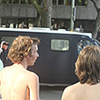Stroom is the local arts body in the city I live in. The city is not very big. To keep cultural live vibrant, the city government tries hard to stimulate the art scene, so that not all artists move to more famous cities. As part of this, for the second time I will be part of a program that introduces artists to curators.
I remember the director of Stroom explaining to us, how do we deal with a curator. We should not act too self-assured. Rather, we present an open ended view of our work. Also, we must not expect these curators to make exhibitions with us. We get taught to be subservient.
Well I'd rather be inquisitive. Once again, I'll spend three days talking to art professionals. I'm not going to try and act spontaneous. This time I'll be keeping notes and I'll share them here. I hope we can answer this question: can the world of contemporary art be fixed?

Good choice of words. I like inquisitive better than critical.
Reply
At the public discussion, nobody wants to be called a curator.
Reply
There is the director of the Palestinian Academy of Art, Khaled Hourani. It’s weird that I am going to be talking with someone who lives in a warzone. His concerns must be different from mine and I hope to learn from that. I am curious what he thinks about all the works made about the conflict, by foreign artists. I’ve seen so much art on the subject of the Israel Palestina conflict. When it’s made by outsiders, it usually doesn’t go beyond telling me what I already know through the news.
Reply
Khaled also narrated on his project Picasso in Palestine. It is very common to take the structure of the art institution as departure point nowadays, but ââ¬Ëinstitutional critique’ hardly ever gets as poignant as this: the project depicts the struggle necessary to get a Picasso into Palestine—a loan from the Van Abbemuseum, who are partners in this project. How do you manage to get a hugely expensive object like a Picasso into a war zone and show it?
Reply
The most classical curator seems to be Bram van Damme. I am curious to ask him about the Radical Autonomy exhibition. It baffles me that in the networked era the concept of autonomy still gets value attached to it… the impossible suggestion of existing apart from others… but the concept keeps popping upagain and again.
Reply
The art world to me seems like the world of fashion, except with less money and less power.
Reply
There are several long standing clichees about the artist. She or he is a free spirit, who, in isolation (preferably on an attic), creates a proper universe from which spring works (objects!) that testify to a singular vision.
In actuality, interesting works only get produced in a scene where likeminded people can meet-likeminded being key here: we are like each other, inform one and other and, through our exchange, at least partly, become each other.
Reply